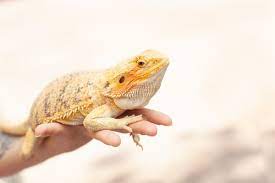Reptiles originate from hot, dry deserts or habitats with very specific requirements for their survival.
It is very important when considering whether to keep a reptile as a pet, that you understand what sort of controlled environment you will need to provide, and that you learn as much as you can about how to care for them beforehand. At PAWS we have the knowledge and expertise to guide you in caring for your reptile. On these pages we have provided some general information and guidelines about caring for the most popular reptiles, however, we advise that you come and visit us in the shop for a chat about your reptile's specific needs.
 Bearded Dragons are one of the easiest lizards to care for. They get their name from the pouch under their neck, which they inflate whenever they feel threatened. Bearded Dragons are docile, friendly and easy to handle making them great pets for older children and adults.
Bearded Dragons are one of the easiest lizards to care for. They get their name from the pouch under their neck, which they inflate whenever they feel threatened. Bearded Dragons are docile, friendly and easy to handle making them great pets for older children and adults.
Housing
An adult bearded dragon will need a vivarium with a minimum length of 90cm. If you’re keeping a pair of dragons, the vivarium will need to measure at least 120cm in length. You will need to provide a hot/basking spot for them and arrange some hiding spaces. Male bearded dragons are territorial so are best housed singly.
Furnishing
The bottom of the vivarium should be covered in a substrate such as sand, coconut bark chips, aspen wood-shavings or artificial grass. Provide something for your dragon to climb on such as a branch or secure rockwork. Provide shelter such as a piece of cork bark and additional bark. Include a spotlight or UV lamp for basking.
Temperature
 One end of the vivarium should be heated. This creates a thermal gradient allowing lizards to choose its preferred temperature. Thermal gradient: 26°C-28°C at the cool end, up to 40°C at the hot end. Night time Temperature: minimum 16°C-18°C for adults.
One end of the vivarium should be heated. This creates a thermal gradient allowing lizards to choose its preferred temperature. Thermal gradient: 26°C-28°C at the cool end, up to 40°C at the hot end. Night time Temperature: minimum 16°C-18°C for adults.
Lighting
Bearded Dragons require high intensity UVB lighting in order to fully absorb and utilise the calcium in their diet. Lighting should be left on for 12-14 hours per day.
Humidity
Bearded dragons require low humidity and good ventilation.
Diet and Feeding
Bearded Dragons are omnivores so enjoy a varied diet of live insects, fruit and vegetables.
Their diet should include: crickets, locusts, giant mealworms, pinkie mice, kale, dandelion, watercress, carrots, courgettes, parsley, apples, pears and berries in limited quantities.
We can advise you about how much and how regularly to feed your dragon based on its age. Ask us in-store.

Handling
To pick up your dragon, place one hand above the shoulder and support the underside with your other hand.

